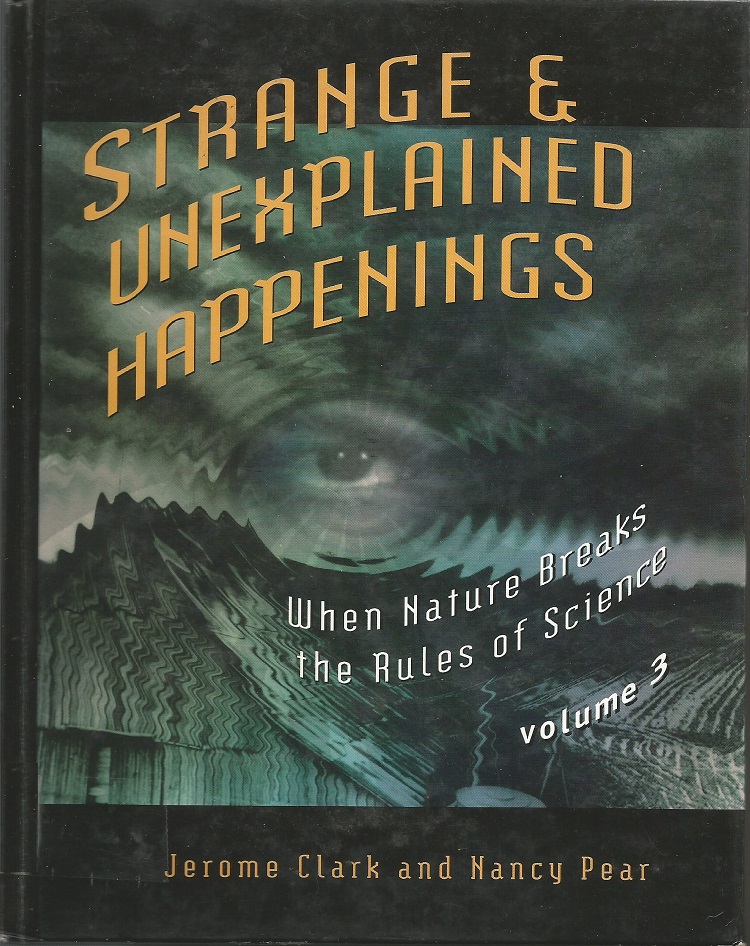By cryptozoologist Jonathan Whitcomb
UPDATE: The links on this post (on non-fiction books about modern pterosaurs) have been shown to be safe, with “https” in the URL’s.
.
Let’s take a brief glance at a number of publications, each of which could be considered a paranormal book.
Strange & Unexplained Happenings (Volume three)
At the beginning of the book it says about itself:
. . . It picks up where the studies of the occult and parapsychology leave off, telling the rest of the story of the world’s mysteries—those dealing with strange natural and quasi-natural phenomena, things that seem to be a part of our world but are usually disputed or ignored by conventional science.
In the chapter “Folklore in the Flesh,” the first section gives us the following locations for creatures that some modern cryptozoologists could suspect were living pterosaurs:
- Sudsexe (Sussex, England): 774 A.D. (serpents in the sky; fiery dragons)
- Devonshire, England: 1762 (“twisting serpent” lit up the sky)
- Nebraska, USA: mid-1800’s
- Missouri River, USA: 1857-1858 (“flying serpent”)
- Bonham, Texas, USA: 1873 (enormous serpent in a cloud)
- Kansas, USA: 1873 (huge flying serpent)
- Maryland, USA: 1883 (monstrous flying dragon)
- Tanzania, early 20th century (flying dragon)
- Namibia, early 20th century (large flying snake)
- South Carolina, 1888 (huge serpent moving through the air)
Some of the above reports come from old newspaper articles.
.
Mysteries of the Unexplained
(Readers Digest Association; 1982)
The following potential flying creatures are mentioned on page 165:
- Fire-breathing dragons
- Thunderbird (American Indian lore)
- Jersey Devil
- Kongamato
- Mothman
Folk Lore And Folk Stories of Wales
(first published in London in 1909, reprint in 1973)
On page 168, we read:
“. . . the winged were described as very beautiful. They were coiled in repose, and ‘looked as thought they were covered with jewels of all sorts. . . .’ it was ‘no old story’ invented to ‘frighten children,’ but . . . a real fact. His father and uncles had killed some of them, for they were ‘as bad as foxes for poultry.'”
###
.
. . . some of the nonfiction books are entirely about these featherless flying creatures and others include cryptids of other types or even are mostly about paranormal events in general (with non-extinct “pterodactyls” making up only a small part).
.
Strange & Unexplained Happenings
Volume 3: When Nature Breaks the Rules of Science
The first section of the chapter “Folklore in the Flesh” has a number of references to old sightings, at least some of which could have been encounters with non-extinct pterosaurs.
.
Living pterosaurs in old newspapers
An 1891 issue of the Los Angeles Herald newspaper had an article from an earlier California news publication, about reports of “dragons” flying over an area south of Fresno, around Selma.
.
Not Misidentified Frigate Birds
I know of three cases in which a person has seen a frigatebird, or a photo or video of that kind of oceanic bird, and thought it was a living pterosaur (or at least he put forward the idea that it was a non-extinct pterosaur). Take that in context: Over the past thirteen years, I’ve looked at hundreds of eyewitness sighting reports of possible living pterosaurs.
.
Science and Pterosaur Extinction
In science, Occam’s razor has also been called “the law of succinctness,” but the simplicity of that label can be misleading. It does not really mean “the simplest explanation is most likely correct.” A better definition might include “when competing hypotheses are otherwise equal in explaining something, the simpler hypothesis deserves preference, unless and until the less-simple one is someday found to explain things better.”
.
I would be delighted if many American newspapers would publish stories like that, for I feel sure that someday, in some town or city in America, some newspaper professional will be struck by the possibility that maybe great blue herons are not playing dress-up. Will that article, whenever and wherever it will be published, fly well enough for a Pulitzer Prize? I’m willing to help that writer make a run for it.



